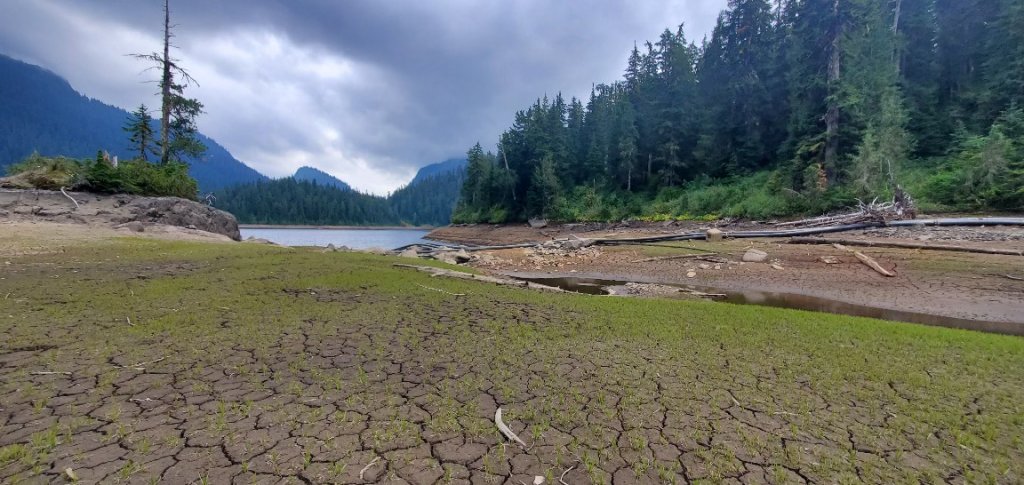
By
Kamyar Razavi
Global News
Published October 8, 2022
7 min read

By this time of year, the so-called ‘wet coast’ of Canada should be blustery, wet and cold — some would even say miserable. Vancouver should be living up to its reputation as “Raincouver.” Fall colours, along with the downpours, should be in full swing.
But coastal British Columbia has not had significant rain since July. The leaves on the trees are yellow and orange — and hanging by a thread because they’re completely dried out.
It’s a tinderbox.
Just north of Vancouver, along B.C.’s Sunshine Coast, it’s situation critical.
The area reservoir is on its last legs. The levels are so low at Chapman Lake, it can’t supply enough water through a nearby irrigation channel. It has meant siphoning water out of the middle of the tiny lake using helicopters.
He’s worried that if the dry spell drags on, they’ll be unable to supply enough water to the region’s 22,000 residents, to say nothing of providing enough to the local hospital or firefighters. The hope is that there’ll be water to last until early November, but that’s just three weeks away.
“All kinds of options are being explored and planned for,” Rosenboom said, including trucking water from outside. Already, the region is bringing in a bit of water, about 3 per cent, from a neighbouring municipality that relies on a different water supply. They’re exploring shipping in water from the Lower Mainland if things get even worse.
For coastal First Nations, the impact is personal. The heat is hitting the lifeblood of the community — salmon — hard.
Last week, during a routine run to assess stocks in local rivers and streams, salmon counters working with Heiltsuk Nation in Bella Bella, B.C., stumbled across what they estimate to be between 65,000 to 80,000 dead fish.
William Housty, a resource manager with the Nation, says tens of thousands of salmon had been ‘tricked’ by a few millimetres of rain that had fallen over the previous days into thinking more sustained rains were about to come.
“The river levels started to fall, and the pools dried up, and they just ran out of real estate to live in and spawn,” Housty told Global News. “They just died in vast numbers.”
The heat and drought are affecting entire ecosystems, impacting the natural feeding cycle of animals, including wolves, bears and birds.
“It’s devastating.”
Weather experts are just as stunned by the abnormally hot and dry conditions.
“I don’t remember anything like this in the 20 years that I’ve been doing forecasting,” says Global BC senior meteorologist Kristi Gordon. She points to data from Environment Canada showing how virtually every community in B.C. was warmer and drier than normal in the month of September.
The city of Abbotsford was supposed to get 164 millimetres of rain from July to September but received less than a tenth of that amount. The city says levels at the two lakes it relies on for its water are lower than normal, but still in safe territory thanks to the spring rains and delayed snowmelt.
As for Vancouver, known around the world for its rain, got just a third of its expected precipitation total for the summer.
“It truly is exceptional,” Gordon says.
There have been little bursts of rain here and there, but it’s been more of a tease than actual relief. Environment Canada is calling for showers on Monday. But beyond that, more dry weather.
Luckily, a wetter-than-normal spring along with a higher snowpack last winter has prevented reservoir levels from falling into dangerous territory in the Metro Vancouver area, the region’s population hub.
“We’re still well within the normal range for this time of year, so we’re in really good shape,” says Heidi Walsh, the director of Watersheds and Environment for Metro Vancouver. Still, she says, conservation is the order of the day, and restrictions could be expanded if conditions don’t improve. “We’re really hoping we don’t get there.”
There was the heat dome last summer, resulting in never-before-seen temperatures in Canada, and over six hundred deaths. Then there were the atmospheric rivers last November that dumped a month’s worth of rain over the course of a day or two and washed out huge stretches of highway.
Now, it’s more heat and drought — in October — which is changing the nature of fighting wildfires in British Columbia.
Already, there have been a higher-than-usual number of new fires in B.C, despite the lack of wind and lightning. The extreme, dry conditions mean that “the availability of fuel to burn is still there in a pretty big way,” says Briana Hill, an information officer with the provincial wildfire service.
But drought, says Hill, has impacts on the landscape that extend well into the future. Arid conditions affect the overall health of forests. “More challenging wildfire seasons tend to follow one, two, three years of drought.” In other words, this year’s shortfall could portend trouble for next year’s wildfire season.
In the Fraser Valley, where it feels close to 30 degrees in October, farmers are optimistic that the rains will eventually come, said Stan Vander Waal, a local flower grower and Chair of the BC Agriculture Council.
Don’t tell that to cattle rancher David Zehnder. “I’m looking out over some of our pasture land and it’s brown,” Zehnder said from his ranch near Invermere, B.C.
Usually, fall rains help replenish the soils, but it’s been so hot and dry again this year, they haven’t been able to produce enough feed for the cattle. That means that they’ve had to resort to buying feed, a huge expense, for a second straight year.
The droughts hitting B.C., and those that have affected West-Central Europe and parts of China, are 20 times more likely because of human-caused climate change, according to a new report by World Weather Attribution, a group made up of international researchers.
Climatologists take pains not to attribute extreme weather events to climate change. There is, however, little doubt that seasons, and the weather patterns associated with them, are shifting on the West Coast because of the climate crisis.
This fall, that change is being driven by a significant area of warm water in the Pacific Ocean pushing against the West Coast of North America. It’s responsible for the pattern that’s locking in the summer-like conditions, climatologists say.
“When the ocean is warmer, air temperatures inland, especially in the coastal regions, tend to be warmer than normal,” said Nicholas Bond, a climatologist and research scientist at the University of Washington.
The jet stream, bands of fast-flowing wind in the upper reaches of the atmosphere, is another related factor that weather experts are looking closely at.
Meteorologist Kristi Gordon said that as the Arctic warms up, the difference in temperature between the polar regions of the planet and the warmer, equatorial zones becomes less and less.
That reduction in temperature gradient between the Arctic and the equator in turn weakens the jet stream. A weaker jet is less capable of disrupting persistent weather patterns.
“The jet stream just doesn’t have the strength anymore to move itself out of that pattern,” Gordon said. Extreme weather patterns, as a result, can get ‘stuck.’
“It just doesn’t seem to want to go away,” agreed University of British Columbia climatologist Michael Pidwirny, referring to a locked-in pattern of high pressure spawned by those warm ocean temperatures and abnormal jet streams. As a result, clouds, and precipitation, are unable to form, he said.
On the ground, the effects of those changes hit people hard. It might mean minor inconveniences like not being able to water your lawn or wash your car. Then there are the more serious implications. Farmers have to adapt. Salmon stocks are hit. Air quality takes a dive.
From food security to entire ways of life, what’s happening is having dangerous ripple effects, said William Housty of the Heiltsuk Nation.
“When that domino starts to fall, all those other dominoes collapse too.”


Comments